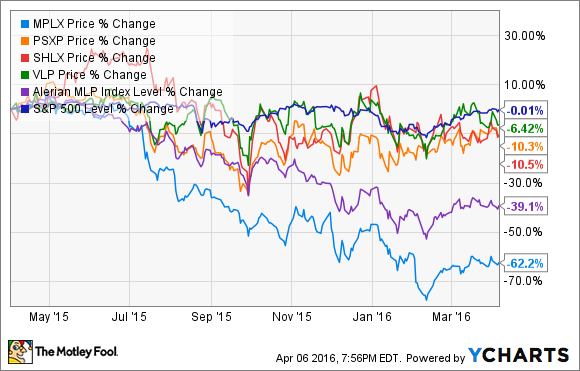
Source: Valero Energy Partners
Energy prices have proven far less predictable than almost most Wall Street supposed "experts" predicted. This has resulted in most energy stocks, even supposedly secure dividend paying midstream MLPs such as MPLX (MPLX +0.92%), getting taken to the cleaners over the past year.
Yet as you can see, fast growing, refiner sponsored midstream competitors such as Phillips 66 Partners (PSXP +0.00%), Shell Midstream Partners (SHLX +0.00%), and Valero Energy Partners (NYSE: VLP), have held up amazingly well over this same time period.
Find out why investors have soured on MPLX so such a great extent, and most importantly, whether or not they're wrong to have punished this MLP so severely.
The cause for the price collapse
"These factors contributed to our decision to provide new distribution growth guidance..to an expected 12% to 15% distribution growth rate for 2016 revised from the prior 25%." -Gary Heminger, Chairman and CEO, MPLX
MPLX and its peers have always been sold to investors under a long-term income growth thesis, and thus it's understandable that a 50% reduction in growth guidance would cast doubt on that growth potential.
What's more, the guidance, which had previously been for several years, is now only for this year. Thus many investors may be concerned that, should energy prices not recover for several years, future quarters will bring even more downward guidance revisions.
While that risk is real, to understand whether or not MPLX's current valuation makes sense, and whether or not it potentially deserves a spot in your diversified income growth portfolio, one needs to understand why the collapse of crude prices haven't hit the MLP's competitors in the same way.
Mega-merger with MarkWest was badly timed
"The continued decline in commodity prices and the market's increasing belief that these condition will persist for some period of time has a direct impact on our producer customers. Well our producers are in some of the best areas and continue to manage our capital production plans very carefully but changes in volume growth will continue to impact income growth for the partnership." - Heminger
The reason that Wall Street has increasing doubts about MPLX's ability to deliver on its distribution growth promises is because of its recently closed merger with MarkWest Energy Partners.
Previously MPLX didn't have direct exposure to oil or gas producers since its cash flows came from acquiring and obtaining long-term, fixed-fee cash flow from its sponsor and general partner, refining giant Marathon Petroleum (MPC +0.13%). This is the same commodity insensitive business model used by Phillips 66 Partners, Shell Midstream Partners, and Valero Energy Partners.
MarkWest however, operates gas gathering, processing, and transportation infrastructure in the prolific Marcellus and Utica shale formations and so the assets MPLX now owns mean that its cash flows are partially reliant on natural gas and NGL prices.
Because both commodities have fallen to more than 10 year lows MPLX's new MarkWest assets have thus far proven to not provide a boost to distributable cash flow or DCF, which is what funds its distributions.
For example, in Q4 of 2015, MarkWest's contributions to MPLX's DCF was -$16 million. In other words, until gas and NGL prices recover MPLX may not benefit from the kind of DCF growth they were expecting. In the meantime though, the MLP's balance sheet and unit count were greatly expanded by the large amount of equity and debt it had to use to fund the deal.
Which brings me to the biggest difference between MPLX and these other refiner sponsored fast growing midstream MLPs. That difference is the key to understanding Wall Street's reaction to MPLX over the past few months and determining whether or not this midstream operator deserves a spot in your portfolio.
Limited liquidity making Wall Street question the growth story
"We intend to reduce leverage during the year through growth and EBITDA, and we do not anticipate any net new debt in 2016. We anticipate utilizing a combination of funding from MPC and opportunistically accessing the capital markets from the equity perspective to fund our 2016 growth capital plans."-Nancy Buese, CFO, MPLX
The midstream MLP business model is dependent on ongoing access to cheap debt and equity capital to achieve profitable growth in DCF.
With its unit price having crashed by so much investors were worried that MPLX wouldn't be able to raise equity at a high enough price to make drop downs such as Marathon Petroleum's inland marine assets accretive to DCF per unit.
However, thanks to the recent strong rally in oil prices MPLX's price soared and it recently struck a deal with its sponsor to buy Marathon Petroleum's marine division for $600 million via a 23 million unit equity offering, priced at $26.09, which represents 7.7% investor dilution.
Thanks to its sponsor waiving all Q1 2016 distributions from MPLX this deal's low price/EBITDA ratio of 5.0 should prove accretive to MPLX's DCF per unit. In fact, management is forecasting for around $3.24 per unit in 2016 DCF which should easily cover not only the current $2 distribution (7.2% yield) but also allow for its 12% to 15% payout growth target as well.
Bottom line
With far more debt and access to debt and equity growth capital markets far lower than those of Phillips 66 Partners, Shell Midstream Partners, and Valero Energy Partners, investors need to understand the higher risk they're taking by investing in this MLP.
However, while MPLX's short-term growth capital access may be lower than its peers, I believe its higher-yield adequately compensates long-term income investors. Thus I still think it's worth considering at today's prices given the inevitable -- if completely unpredictable -- recovery in energy prices.
